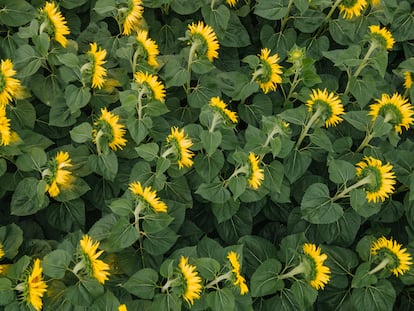How sunflowers follow the sun from day to day
A study delves into the behavior of these plants and challenges earlier assumptions about their dependence on sunlight

Every day, like clockwork, sunflowers wake up and bend toward the sun, following its path from east to west. The phenomenon is called “heliotropism,” a set of movements in which plants direct their leaves and flowers toward sunlight. Until now, scientists had attributed this ability to a photoreceptor called phototropism, but a new study published on Tuesday in PLoSBiology has found that multiple types of photoresponses are necessary for sunflowers to bend toward the sun. Researchers at the University of California dug deeper into the behavior of these plants, and the results challenge previous assumptions about sunflowers’ dependence on light.
In 2016, plant biologist Stacey Harmer and her team discovered that young sunflower plants track sunlight as a result of distinct patterns during stem growth. In the experiment, researchers observed that lab-grown plants grew symmetrically and most of their development occurred at night. In contrast, flowers exposed to natural light grew during the day on the east side of the stem, so they started the day leaning in that position and bent toward the west as the hours went by. When night came, the east side stopped growing and the plants grew on the west side of the stem, so that they ended up facing east again just before dawn.
Now, the same scientists have asked how these plants perceive sunlight and which molecular pathways generate their growth patterns. Harmer says that their “surprising” results suggest that sunflowers’ sun tracking is more complex in the real world than what they have studied in the laboratory. For the study, they looked at which genes were activated in sunflowers grown indoors and which were activated in sunflowers grown naturally. Indoors, the plants grew directly toward artificial light, activating genes associated with phototropin. To the researchers’ surprise, sunflowers grown outdoors showed no significant differences in their response to the movement of the sun. But in outdoor plants, researchers identified other light reception systems, including one to avoid red light — which was generated in the shade — that was activated on the west side of the sunflower stem early in the day, when the sun is in the east.
Given these behaviors, the researchers concluded that there are multiple pathways that respond to different wavelengths of light to achieve the same goal, but they failed to identify the genes involved in heliotropism. “Understanding the molecular pathways involved in solar tracking will provide tools to help breeders generate plants that retain this ability,” the scientist explains.
Among the things that most surprised the authors of this new study was how quickly these plants learn. When sunflowers grown in the lab were moved outdoors, “they started following the sun from day one.” According to Harmer, this suggests that the lab plants underwent some kind of “rewiring,” and that those sunflowers that are allowed to follow the sun grow better than those that are not.
Why do old sunflowers lose this ability to bend toward the sun?
Sunflowers’ ability to follow the sun is unique to the youngest plants. Once they reach maturity, their movement stops. They do not bend again for the rest of their lives and stare westward indefinitely until they die. To understand this behavior, in an earlier study, the plant biologist and her colleagues immobilized young plants’ stems to prevent them from moving to follow the sun. Other sunflowers were placed in pots facing east, so at the next sunrise they were facing away from the sun. Others were exposed to intense blue light, altering the day/night cycles, switching from 24 hours to 30 hours in the growth chamber.
As a result, the researchers found that tracking the sun is good for sunflowers’ development. The manipulated sunflowers lost up to 10% of their biomass and the size of their leaves was visibly reduced compared to the non-manipulated flowers. They also found that those that had the blue LED on them all the time continued to move from east to west for several days. The rotation of the sunflowers that were made to believe that days were 30 hours long ended up being erratic. That is because of the sunflowers’ circadian, or internal, clock, which tells them when and how much to turn. Thus, they make the most of the sunlight that is vital for their photosynthesis, while encouraging the production of growth hormones.
However, being older also has its advantages. When sunflowers stop growing, they stop moving in search of the sun, but they begin to give off additional heat, which makes them more attractive to pollinating insects; in turn, that pollination allows older sunflowers to reproduce.
Sign up for our weekly newsletter to get more English-language news coverage from EL PAÍS USA Edition
Tu suscripción se está usando en otro dispositivo
¿Quieres añadir otro usuario a tu suscripción?
Si continúas leyendo en este dispositivo, no se podrá leer en el otro.
FlechaTu suscripción se está usando en otro dispositivo y solo puedes acceder a EL PAÍS desde un dispositivo a la vez.
Si quieres compartir tu cuenta, cambia tu suscripción a la modalidad Premium, así podrás añadir otro usuario. Cada uno accederá con su propia cuenta de email, lo que os permitirá personalizar vuestra experiencia en EL PAÍS.
¿Tienes una suscripción de empresa? Accede aquí para contratar más cuentas.
En el caso de no saber quién está usando tu cuenta, te recomendamos cambiar tu contraseña aquí.
Si decides continuar compartiendo tu cuenta, este mensaje se mostrará en tu dispositivo y en el de la otra persona que está usando tu cuenta de forma indefinida, afectando a tu experiencia de lectura. Puedes consultar aquí los términos y condiciones de la suscripción digital.
More information
Últimas noticias
Reinhard Genzel, Nobel laureate in physics: ‘One-minute videos will never give you the truth’
Pinochet’s victims grapple with José Antonio Kast’s rise in Chile
How Japan is trying to avert ‘digital defeat’
The complicated life of Francesca Albanese: A rising figure in Italy but barred from every bank by Trump’s sanctions
Most viewed
- Pablo Escobar’s hippos: A serious environmental problem, 40 years on
- Why we lost the habit of sleeping in two segments and how that changed our sense of time
- Charles Dubouloz, mountaineering star, retires at 36 with a farewell tour inspired by Walter Bonatti
- Trump’s obsession with putting his name on everything is unprecedented in the United States
- The Florida Keys tourist paradise is besieged by immigration agents: ‘We’ve never seen anything like this’











































